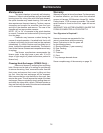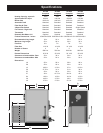
13
The amount of shaking is critical. Too much will disrupt the
rebedandtoolittlewillrestricttheairow.
Theproperamountnormallyoccurswhenredcoalsrst
start to drop through the grates into the ash pan.
Ashes - Ashes should never be allowed to accumulate
intheashpitsothattheyinanywayimpedetheowof
combustionairtothere.Excessashaccumulationcan
causetheretogooutandalsocancauseseveredamage
tothegratesbecauseoftheabsenceofacoolingowof
air beneath them.
Ashes should be placed in a metal container with a tight
ttinglid.Theclosedcontainerofashesshouldbeplaced
onanoncombustibleoororontheground,wellaway
fromallcombustiblematerials,pendingnaldisposal.If
the ashes are disposed of by burial in soil or otherwise
locally dispersed, they should be retained in the closed
container [outside the dwelling) until all cinders have
thoroughly cooled.
CAUTION: ASHES SHOULD NEVER BE ALLOWED TO
ACCUMULATE ABOVE THE TOP OF THE ASH PAN.
ASHES IN CONTACT WITH THE BOTTOM OF THE
GRATES ACT AS AN INSULATOR, INTENSIFYING THE
HEAT ON THE GRATES, AND COULD CAUSE THEIR
WARPAGE. WITH AN EXCESSIVE ASH BUILDUP,
PRIMARY COMBUSTION AIR IS RESTRICTED. THUS
THE UNIT’S OUTPUT COULD BE REDUCED.
Coal produces considerably more ash than wood. So the
intervals between emptying are much shorter. For equal
heat output,coal will produce seven to ten times more ash
than wood.
Draft Control Settings - The idle air adjustment on the
apperdoormayneedtobeadjustedslightlylessforcoal
than for wood. Here again, experience will dictate the best
setting. The maximum air adjustment bolt can be set at
the maximum position for quick recov-
ery. When a longer than normal burn time is desired, the
maximum air adjustment can be reduced. Never adjust
themaximumairboltwhentheapperdoorisopened.
See Fig. 6 on page 11.
Safety Tips
When opening the loading door, it should be cracked
open slightly for a few seconds to allow oxygen to burn
any gases that may be present and to allow smoke to be
drawn away from the door.
Whenever the bottom door is open, it should be closed
before opening the loading door. This is to increase draft
through the loading door and prevent excess smoke from
escaping.
Thereboxshouldneverbelledwithexcessivecoalso
thattheueexitisblockedorimpededinanyway.Burn-
ingcoalgeneratescarbonmonoxide.Iftheuegasexitis
blocked, the carbon monoxide can be forced out of the fur-
nace into the room with possible fatal consequences.
With the exception of start up or increasing heat from a
lowre,orremovingashes,thebottomdoorshouldbe
kept closed. Never install a Harman furnace to a chimney
with a history of down drafts.
KEEP CHILDREN AWAY - MAY CAUSE SERIOUS
BURNS.
CAUTION: ALL SURFACES OF FURNACE ARE HOT.
DO NOT TOUCH. KEEP CHILDREN AWAY. SERIOUS
BURNS WILL RESULT IF TOUCHED. THIS IS A HEAT
PRODUCING APPLIANCE.
FUEL/FIRING WARNINGS -
DANGER! FIRE HAZARD! DO NOT USE CHEMICALS
OR FLUIDS TO START OR “FRESHEN UP” A FIRE.
SEVERE BODY BURNS OR A FIRE IN YOUR HOME
COULD RESULT. DO NOT BURN GARBAGE,
GASOLINE, THINNERS, DRAIN OR ENGINE OIL,
KEROSENE, OR FUEL OIL, ETC. AN EXPLOSION,
A HOUSE FIRE OR PERSONAL INJURY COULD
RESULT. KEEP ALL SUCH LIQUIDS WELL AWAY
FROM THE FURNACE WHILE IN USE.
Chimney Problems
Not Enough Draft - Chimney is too low. A chimney
should be two feet higher than anything ten feet around
it.
Airmaybe leakinginaround aloosettingclean-out
door,uepipemaynotbetightatjoints,orthemasonry
may be defective.
Chimney may be blocked with creosote or bird nests,
etc.
Improper sized chimney or stovepipe.
Too many elbows.
Distance of more than eight feet between furnace and
chimney.
Down Drafts - Trees or other topographical barriers may
impede the chimneys operation causing a down draft
condition to exist. This can also be caused by adjacent
buildings or chimneys.
Creosote and Condensation - If creosote or
condensation runs out of the chimney or stovepipe,
check the following.
Chimney cap or lining may be defective.
Furnace may be too far from chimney, not allowing the
chimney to get warm.
Wood being burned may be green or wet.
Unit may be too large for home causing wood to be
burned too slow.
Excessive Draft - This can be controlled with a
barometric draft control on the stovepipe.
Operating Instructions/Safety Tips


















